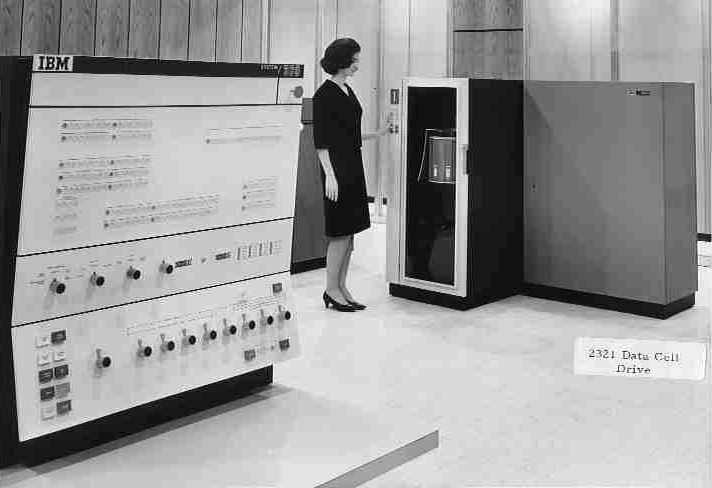To: Tarpon; Bloody Sam Roberts; mamelukesabre; Richard Kimball; Future Snake Eater
Fry's has a weekend sale going with Seagates 1.5 Terabyte drive at 124.xx no rebate required.......
I would say that Seagate sees something coming also....
I could see having a system with the operating system on SSD and a spinning Large drive for user Data.......
Kind of like what we did on the mainframes years ago...
Anybody remeber the IBM DataCell??
The IBM 2321 Data Cell Drive

The total storage capacity was 400 million bytes or 800 million decimal digits. Up to eight 2321s could be attached to the IBM 2841 control unit, allowing an overall capacity of over 3GB. Reportedly the Data Cell required 23 liters of motor oil.
Average access times for selection of a strip range from 175 to 600 milliseconds; average rotational delay one a strip is on the drum is 25 milliseconds; access time to another cylinder averages 95 milliseconds.
To: Ernest_at_the_Beach
I can see the OS on a 32 GB SSD and the data stored on HDs. I have a system like that, but you are much better off just cranking up the main memory size from my tests. Boot from bios ROM.
Ah the DataCell, when drives were huge, and men were men. Nothing can replace the roar of the fans and rumble of the bits going round and round. Sends a shiver up the pant leg from the underfloor cooling.
I long for times gone by. At the university space science research center where I worked on our solar wind experiments, we actually had twin tape drives for storage. Full cabinets each.
23 posted on
03/16/2009 2:10:18 PM PDT by
Tarpon
(It's a common fact, one can't be liberal and rational at the same time.)
To: All
The followon to the Data Cell:
IBM 3850 mass storage system
******************************EXCERPT*************************

IBM 3850 Mass Storage System
- IBM 3850 Mass Storage System announced October 9, 1974
- IBM 3851 Mass Storage Facility Models A1-A4 and B1-B4 announced October 9, 1974 and withdrawn August 5, 1986
- IBM 3851 Mass Storage Facility Models B11-B13, B21, B22 and B31 announced March 6, 1980 and withdrawn August 5, 1986
Beginning in the late-1960s, IBM engineers in Boulder, Colorado, began development of a low-cost mass storage system based on magnetic tape in cartridges. By 1970, the proposed device was code named "Comanche" and described as an online tape library to provide computer-controlled access to stored information. Numerous marketing studies and design changes were made during the early 1970s, and finally Comanche was announced as the IBM 3850 Mass Storage System (MSS) in October 1974.
The components of the 3850 were new data cartridges, one or two units of the IBM 3851 Mass Storage Facility, the new IBM 3830 Storage Control Model 3, and the widely-used 3330-series disk subsystem.
The data cartridges were circular cylinders, two inches in diameter and four inches long, each holding a spool holding 770 inches of tape. Cartridges were stored in a two-dimensional array of bins, which were hexagonal, rather than square, to save space.

The 3850's honeycomb storage compartments
During its development, Comanche evolved in concept and design from a tape library to a means for storing infrequently-used information that otherwise would reside on disk storage. Information under control of the MSS was stored in Direct Access Storage Device (DASD) format images on the low-cost cartridge tape.
To: Ernest_at_the_Beach
That’s my plan for the next computer I build. I’ll throw a VelociRaptor (or something similar) in as my “application” drive, and use a 1.5-2TB drive as my storage. I also have an HP EX485 home server as a backup for data. :-)
26 posted on
03/16/2009 2:58:35 PM PDT by
Future Snake Eater
("Get out of the boat and walk on the water with us!”--Sen. Joe Biden)
FreeRepublic.com is powered by software copyright 2000-2008 John Robinson


